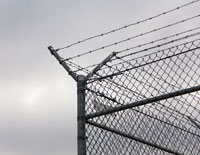News & Commentary
Shackling: Ohio Juvenile Courts Should Have Rules on Restraints
This is the third in a series of posts on the topic of juvenile shackling. This is Nate P. and I’m writing you this letter to let you know that cuffs and shackles make me feel like a criminal, not a “juvenile delinquent.” Shackles hurt and embarrass me most of the time. My opinion is that they are not necessary. When I wear cuffs and shackles I am judged immediately. I am writing this letter to you so that we can come up with a solution. What if one of your sons or daughters was shackled for a minor, non-violent crime? Think about it, we are kids.

Worse Than Adults: The Shackling of Youth in Juvenile Court
Tim Williamson,’ Detained youth,
Forty-seven years ago, the U.S. Supreme Court’s landmark ruling In re Gault held that young people are entitled to the same procedural rights as adults in court proceedings. However, one right that adults have in Ohio, that young people do not have, is the right to appear in court free of restraints.
Courts have ruled that restraints may only be used on adults who pose a safety risk or who have a documented history of escape. Adults in Ohio and around the country have the right to appear in court without handcuffs, belly chains, or leg irons regardless of the charges they face. Only an adult who has been documented to be a serious safety risk may be shackled, and the court must use due process and evidence to determine this. The use of restraints in adult courts is rare.
Youth in several states in the nation have the right to appear in court unrestrained. However, in Ohio’s juvenile courts, the use of restraints is common.
Due to this inconsistency between Ohio’s adult court and juvenile court, an adult facing multiple serious charges will not wear restraints while a youth facing minor or non-criminal charges will.
This does not seem right, does it?
Research and the U.S. Supreme Court have found that minors are less culpable and more amenable to rehabilitation than adults.
So why are we treating them more harshly than adults?
We must treat our youth as well—or better—than we do adults in the justice system. It’s time to unshackle Ohio’s youth.

Treating Our Addiction to Mass Criminalization
“The United States will never be able to prosecute or incarcerate its way to being a safer nation,” said last week U.S. Attorney General Eric Holder, at a conference held by the Brennan Center for Justice at the New York University School of Law.

You Are Never Too Young To Ask For an Attorney
“We are only 14 years old. We aren’t thinking about lawyers,” a teen declared in the middle of a presentation I was giving at his high school.

Stay Informed
Sign up to be the first to hear about how to take action.
By completing this form, I agree to receive occasional emails per the terms of the ACLU’s privacy statement.
By completing this form, I agree to receive occasional emails per the terms of the ACLU’s privacy statement.



